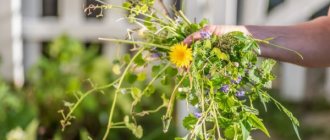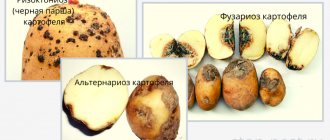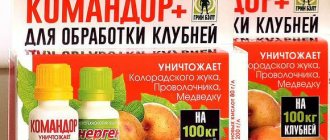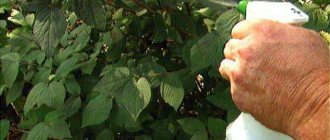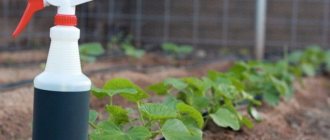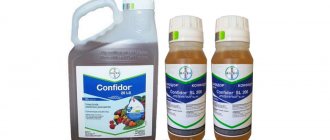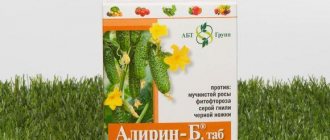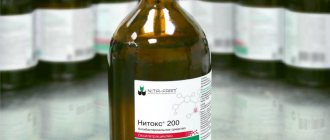How to use against weeds on potatoes: instructions
Treatment is carried out even before grass appears on the soil surface. It is advisable that the crop be dug deep enough so that the herbicide chemicals do not affect the potatoes.
Instructions for use:
- Before planting, it is recommended to water and loosen the soil well;
- It is necessary to treat with the drug in good and calm weather;
- For 1 square meter of garden, 1-1.5 kg of herbicide is used;
- treatment is carried out by watering at the root or by spraying the foliage using a sprayer (if the grass has already grown).
When using the drug you must observe:
- processing times;
- concentration of the substance;
- consumption for single or repeated processing;
- waiting time for the drug to take effect;
- security measures.
Treatment is carried out until weeds appear on the soil surface.
When should it be processed?
You can apply fertilizer in several ways:
- Once . Spray the soil before emergence at a rate of 1.5 kg/m2.
- Twice . First, you should spray the soil with herbicide before the potatoes sprout at a rate of 1 kg per square meter. Treat the second time at a dosage of 0.4 kg per square meter, when potato shoots appear at 5 cm.
For early potato varieties, 0.5 kg of Lapis lazuli is used, for late varieties, 1.5 kg. It is better to start processing at temperatures above 15C.
How to prepare a working solution for use
Stages of preparing the solution:
- The first treatment of the crop is carried out before germination. To do this, you need to prepare a solution: dilute 10 g of the composition in 3 liters of water.
- For the second treatment, mix 10 g of Lapis lazuli with 9 liters of water. The solution must be used immediately.
- First, a fifth of the required liquid is poured into the spray tank, then the rest is added.
- It is recommended to mix the substance thoroughly before use.
How to prepare the solution:
Storage conditions and shelf life
The prepared solution is stored for only 1 day . It's better to use it right away.
In production, it is stored in warehouses that are designed to contain pesticides at a temperature of -10 +40C. Lapis lazuli in packaged form is good for 5 years.
Safety precautions during processing
The drug penetrates only into weeds , so there is no need to worry that it attacks the root crop. However, it is not recommended to spray the chemical too vigorously on the potatoes. It is better if the tubers are buried in the soil to a depth of 15-20 cm.
The solution must not be diluted in a container that will later be used for food. After spraying the product, you need to take a shower and wash your clothes .
Rules for preparing the product
To prepare a working solution of Lapis Lazuli, you need to mix the drug in a large container with water. For this:
- First, dissolve one sachet of product in a liter of water and mix thoroughly.
- Then another 5 liters of water are added to the solution. The resulting solution is used during primary tillage of the soil before germination.
When re-processing, it is necessary to dilute 20 grams of the drug in 20 liters of water. The maximum permissible concentration of the main active ingredient is 0.5%.
Operating principle
Thanks to a set of additives, a continuous action systemic herbicide is well absorbed into the leaves and stems of weeds and affects the roots and rhizomes.
After a week, the weeds begin to dry out , and after a month they die off completely.
The product is well absorbed into the leaves and stems of weeds, affects the roots and rhizomes
Application of Lapis lazuli against weeds on potatoes
Potatoes are the most popular vegetable crop grown in gardens all over the world. Being a rather unpretentious plant, it is quite suitable for mass planting in our country. However, one of the problems you still have to deal with is weeds: you won’t get a good harvest on a neglected field. The most popular method of controlling weeds is chemicals. Lapis lazuli against weeds on potatoes - what are its advantages?
Application of Lapis lazuli against weeds on potatoes
Method of preparing the working solution, consumption rate of “Lazurit”
First of all, you need to prepare a working solution. Since it is recommended for quick use, it should be prepared on the day of treatment. To do this, the container is half filled with water, the required amount of herbicide is dissolved in it, the solution is thoroughly mixed, after which water is added to the required volume.
The herbicide concentration level should be 0.5%. The solution should not be prepared in large quantities; it should be exactly as much as is necessary for processing.
The developers of Lazurit offer the following herbicide consumption rates:
* potatoes – 0.9-1.3 liters per 1 hectare of area. Young weed shoots, the height of which does not exceed 5 cm, are sprayed, or the soil is sprayed immediately after planting potatoes;
* tomatoes – 0.5-1.6 liters per 1 hectare of area. Spray weeds in the 2nd phase of their development.
Operating principle
The active ingredient of the drug is metribuzin. The chemical is aimed at destroying weeds through their sprouts, roots and foliage. This is a fundamental difference from mechanical treatment, in which only the surface layer of weeds is removed, while the root system remains intact. The very first rain will again bring the “pests” into activity.
Once in the soil, the poison acts directly on the root and also blocks the process of photosynthesis, depriving the weed of sunlight. It begins to fade and gradually dries out completely, allowing the potatoes to breathe freely. Many species are sensitive to the weed killer Lapis Lazuli, such as dicotyledonous annuals and cereals (chamomile, quinoa, dandelion, ragweed, sow thistle), as well as perennial herbs. Used by gardeners to protect potatoes and tomatoes from weeds by controlling them. The farmer must remember that the drug helps clean the field, but is not a fertilizer, and therefore will not help the growing process in empty soil with a low humus content.
One of the main advantages of this herbicide is its safety for the crop itself with an effective destructive effect on the weed. However, for the drug to work correctly, the user must strictly follow the instructions.
Pros and cons
In the markets, people are looking for vegetables grown “without chemicals,” “without additives,” and grown in an environmentally friendly way. That is, one in which the weeds were removed in a proven way - weeding. But this is often quite ineffective - weeds sprout again and again, and it is almost impossible to achieve complete removal of weeds.
In addition, due to their characteristics, some crops cannot be weeded frequently - there is a risk of damage to the root system of the plant, the soil dries out, and the yield decreases. When weeding, you can inadvertently re-sow weed seeds. And things will go in a new circle. And weeds are more resilient and difficult to control.
Herbicides developed for this purpose come to the rescue. One of them is lapis lazuli. This product was created specifically for weed control when growing potatoes and tomatoes. When using them, weeds are guaranteed to die, but there is a risk of overdose of lapis lazuli herbicide. This happens quite often - as a result, potatoes cannot be preserved for a long time in winter, quickly spoil, and darken when cooked.
So it’s up to you to decide how to control weeds.
Operating rules
The herbicide is a chemical agent, and therefore should be handled very carefully, following all points. When Lapis Lazuli is used correctly, neither people nor plants will be harmed by weeds.
- The time when you should start using the drug is before potato shoots, before they rise 5 cm above the ground (about 75% of shoots). As the crop grows, its protection against the chemical weakens - which is why timely treatment is so important.
- You should not loosen the soil after spraying so that the drug does not move to the lower layers, where its action is ineffective.
- To prevent heavy rainfall from washing the drug out of the ground, the seedlings should be hung. Drought also negatively affects the effect of metribuzin.
- A little irrigation is still necessary so that the particles of the substance spread in the soil.
- There is a set dosage of the diluted preparation for spraying, which must be strictly adhered to. For potatoes, according to the instructions, it is 250-300 liters per 1 ha. During the first treatment, 10 g of the substance is consumed per 3 liters of water per 100 m2. At the second stage, 10 g of the drug and 9 liters of water are added to the above ratio. The maximum concentration of the working solution should not be higher than 0.5%.
The two methods of using the herbicide differ in the number of stages of spraying procedures. The two-step method is described above: the one-time method involves the consumption of the product from 0.8 to 17 kg per hectare. Care must be taken to ensure that the poison does not get on the vegetable crop, so it should be hidden deep in the ground. Moisten the soil and wait for the ridges to settle.
Related article: How to grow potato seeds - complete technology
Peculiarities
Spraying is best done in dry weather
Potato plants can be treated with the weed killer Lazurit up to two times per season. For early varieties, experts advise using the minimum dose, the maximum - respectively, for late varieties planted in fertile soil. Lapis lazuli dissolves well when stirred in water.
Ideal weather conditions for Lapis lazuli to work are dry, with light rain allowed. It is applied to the soil in finished form, made immediately before use. The prepared solution cannot be stored. The effect of action is observed on average 15 days after treatment and fits within a period of two months. It is the only similar drug whose use is permitted in private households.
Application result
By applying Lapis Lazuli in a timely and technically correct manner, the farmer will be able to defeat not only the first, but also the second batch of weed pests. Once the potato tops close, it will be too late for annual weeds to spread. In addition to combating them, the product helps prevent diseases such as late blight, which negatively affects the yield and safety of the plant.
On peat and bog soils, treatment is carried out upon emergence. During a fungal disease of a plant, an attack by parasites, after experiencing frosts or problems with humidity, all actions are prohibited - only after recovery. There are also overly sensitive potato varieties that can be severely damaged during the baiting procedure.
Advantages and disadvantages of the drug Lazurit
Lapis lazuli actively fights weeds, while remaining very safe for useful crops. Main advantages of the drug:
- The product does not accumulate in soil and plants. Having completed its period of influence, Lapis lazuli “evaporates”.
- Efficiency. Metribuzin particles are almost completely dissolved in water, so they quickly and easily penetrate the plant structure. At the same time, Lapis lazuli is absorbed into both the stems and foliage of the weed.
- Versatility. As indicated in the instructions, the product has a detrimental effect on 50 types of weeds at once. This list includes bristle grass, wild oats, ragweed, meadow chamomile, shepherd's purse, blue cornflower, etc.
- According to the instructions, the use of Lapis lazuli guarantees the complete death of weeds. This means that the treated seedlings of the parasitic plant will not sprout again.
- Easy to use and apply the solution. The instructions for the drug are as detailed and understandable as possible, which makes the process of its use accessible and simple even for beginners.
- Compatibility with other herbicides. Lapis lazuli does not conflict with similar weed killers, so it can be used alternately with them.
- Price. The drug has a low price, while the costs of processing land are reduced and productivity increases.
- Safety. Lapis lazuli against weeds is a relatively low-toxic drug, without irritating effects. Thanks to this, it is not dangerous for bees, moderately dangerous for fish (approved for use in fishery reservoirs). Environmental friendliness lies in the absence of a negative impact on the environment: metribuzin is completely decomposed in the soil within 1 - 3 months.
Among the disadvantages, the only thing that can be highlighted is that chemical agents can cause harm to health upon direct contact with the human body. Therefore, the use of Lapis lazuli should be carried out strictly according to the instructions, taking precautions.
Safety precautions
After treating the field with a chemical solution of the third safety class (moderate), people and animals should not appear there earlier than on the fourth day. No one will be harmed if the required safety precautions are followed.
It is absolutely not necessary to carry out treatment in strong winds, as it can expand the area of action of Lapis Lazuli. The performer, having read the instructions for use of the substance before the process, is obliged to put on a protective suit and goggles, use an oxygen mask or gauze bandage - minimal protective equipment. Smoking and eating are prohibited during the procedure.
Terms of use
Among all herbicides, lapis lazuli is the safest, but when using it you still need to take safety precautions for yourself and for the plants. When purchasing lapis lazuli herbicide, instructions for use are included in each package and must be followed strictly. But also keep in mind
- You cannot make the drug “more concentrated” - this will not improve its quality or enhance its effects.
- prepare the drug on the day of use, it should not be left the next day
- After applying the drug, do not turn over clods of earth. It is better to apply it in cloudy weather or during light rain - this way Lapis Lazuli will mix better with the soil and begin to act faster. In this case, heavy rain will wash the drug into those layers of soil where it will not act. If the weather is dry, the soil should be well watered after adding lapis lazuli.
- Be sure to use rubber gloves and do not inhale the weed killer fumes. Be sure to wear glasses. You can't eat or smoke anything. It is better to wear a protective medical mask or respirator.
- observe the time of use and its duration
- do not exceed the norms of use - this will not have a visible effect.
- The herbicide can be used at an air temperature of at least 15 degrees. At a lower level, its effectiveness decreases.
Before using herbicides, you need to keep in mind:
The potato stems must be large enough and the tubers must be deep in the ground. The drug should not affect potato sprouts.
The soil should be loose so that lapis lazuli penetrates and spreads more easily into the soil.
Where to buy
You can buy Lapis Lazuli to prevent weed growth in almost any gardening store at an affordable price. Its release form is sachets of wettable powder (SP) with a volume of 10 and 20 g. This consistency has economic advantages: suspensions adhere well to plants and adhere firmly to them, so wasted powder is minimal. Instantly dissolves in water and does not form lumps. Shelf life is 5 years. The instructions for use provide recommendations on the use, storage and transportation of metribuzin, as well as how many times it should be used.
How to cook
It is important to prepare the solution immediately before use and apply immediately. It is better to dispose of any remaining substances immediately, as they will quickly lose their beneficial properties. You may also be interested in learning how a potato peeler is used for the Neva walk-behind tractor.
Cooking steps
- The substance still in its original packaging must be mixed.
- The tank intended for spraying must be filled 4/5 with water. Turn on the mixing mode and add as much substance to the water as required according to the instructions.
- Add water to the tank again and mix everything again.
It is important to note that the maximum concentration of herbicide in the tank should not exceed 0.5%. Otherwise, there is a high risk of infecting crop plants along with weeds.
- After treatment, discard any unused solution and rinse the tank with water.
It will also be interesting to know what the best remedy is and what it is called here.
Properties of Lapis Lazuli
A new selective herbicide is aimed at protecting potatoes and tomatoes from weeds. The active ingredient of lapis lazuli is metribuzin. Its action as a herbicide for potatoes is aimed at suppressing the growth of weeds through its effect on roots, foliage and even the development of seedlings. It suppresses the photosynthesis of weeds, depriving them of solar energy and has a detrimental effect on the root system. The main types of weeds are susceptible to its destructive effects, including harmful perennial weeds.
With all its activity, Lapis lazuli does not have a depressing effect on potato and tomato plants. This allows the use of herbicides against weeds on potatoes without causing damage to the main crop.
At the same time, it is important to apply Lapis Lazuli within the time period specified in the instructions, namely before the potatoes sprout and when they rise no more than 5 cm from the surface of the ground. This drug does not act selectively, but potatoes and tomatoes at an early stage of development are resistant to its action. Therefore, it is so important to carry out processing on time.
The effect of herbicides for potatoes begins after application to the soil. At the same time, it is important that after spraying in the given doses the lump of earth is not turned over. Recent light precipitation will help the particles of the substance penetrate quickly into the soil, but heavy rains will wash it into the lower layers, where Lapis Lazuli is ineffective. Dry periods also reduce the activity of metribuzin.
- use Lapis lazuli within the time limits specified in the instructions;
- do not turn over the cultivated soil;
- carry out processing in anticipation of rain;
- do not change the recommended dose of herbicide for potatoes.
Related article: Fertilizers for potatoes when planting in a hole - types and calculation
Operating principle of Lapis lazuli
The secret of such active action of Lapis lazuli lies in a special component. It's called metribuzin. A kilogram of the product contains about 700 grams of this substance. Such a high concentration helps to get rid of a huge number of weeds in a short time.
Before use, the drug must be diluted with water. During watering, the solution penetrates to the roots of the weeds. But you can also use the product externally. To do this, the prepared solution is poured into a container and the plants are sprayed with a sprayer. Lapis lazuli is able to completely clean even a very clogged area. The substance will affect the plants for 2 weeks, and at the end of this period they will die.
The drug remains in the soil and continues to act for 1-2 months. This period depends entirely on weather conditions. In sunny weather, Lapis lazuli will remain active for a long time, and if it rains, then, after a month, it will be better to repeat the procedure.
Instructions for using Lapis lazuli
In order not to be left without a harvest when using lapis lazuli, you need to understand that this drug helps the gardener get rid of weeds that take away nutrition from the potatoes and suppress their growth and development. However, it is not a fertilizer. If there are not enough nutrients in the soil, then the harvest will not please even in the absence of weeds. Treating potatoes against weeds is not a fertilizer. On sandy, thin soils, this drug does not have a visible effect.
In order to correctly and effectively use herbicides against weeds on potatoes, it is important to have a clean field and follow the instructions for use of the drug. From the user manual it will become clear:
- processing time;
- concentration of the drug used;
- drug consumption for single and double treatment;
- waiting time for the drug to act;
- safety measures when working with the chemical and its hazard class.
The question of how to get rid of weeds in a potato field has been resolved. Herbicide applied to the soil on time destroys not only the first weeds, but also maintains the cleanliness of the field until the second wave, suppressing its development. In the future, the tops on the potato bed will close together, and annual weeds will no longer have time to develop. Minimum doses when treating potatoes against weeds are recommended for early varieties of root crops. The greatest consumption should be on dense clay soil when cultivating late potatoes.
The calculated consumption of the diluted substance used by spraying is:
- for potatoes 200 - 300 liters per hectare;
- on tomato seedlings – 500 l/ha;
- on tomatoes from seeds - 300 - 400 l ha.
This does not require dilution of the mother solution. The drug was obtained with nanoparticles and is perfectly soluble in water with vigorous stirring. The solution is used, like all herbicides for weeds on potatoes, in freshly prepared form. Lapis lazuli is the only herbicide approved for use on private farms and for summer residents.
The maximum concentration of the working solution should not exceed 0.5% solution of the active substance.
As a result of the use of lapis lazuli, the soil is freed from weeds for a long period. However, this is not its only useful effect. In the absence of quinoa as a result of treating potatoes for weeds, during cold weather, potato bushes are less susceptible to late blight, which significantly reduces the yield and impairs the storage of root crops. The disease begins to develop on weeds.
The time to enter the treated field for agricultural work is possible no earlier than 3 days.
Reviews of the herbicide
Olga, Nizhny Novgorod
“Previously, I fought weeds manually: I pulled them up by the roots or weeded them. But due to the fact that several years ago we expanded the potato plot, this became quite difficult. My husband purchased Lapis Lazuli, which we used to treat the soil. After a couple of days, all the weeds dried up. I was very surprised. After a while, we repeated the procedure again when we saw new grass sprouts. After that, not a single weed was visible. The product is simply excellent!”
Evgeniy, Krasnodar
“If in a small area it is quite possible to get rid of weeds with your own hands, then in a large field this is simply unrealistic. We started using Lapis Lazuli several years ago and the product has never harmed the crop. It perfectly fights many weeds and retains its effect for a long time. Without him now it’s like being without hands.”
Phytotoxicity of Lapis lazuli and safety measures
The drug Lazurit is toxic to bees. These foragers should not be in the treatment area for 3-4 hours. In this case, the hives should be located at a distance of 2-3 km from the processing site. Due to the scattering of the toxic substance, it is impossible to treat the field when the wind is more than 5 m/s, while the workers themselves must take precautions:
- wear a protective suit while working;
- wear glasses and respirators;
- do not smoke or eat before finishing work.
Despite the fact that the hazard class of the herbicide for potatoes is assigned third, safety measures must be observed.
First aid for poisoning
After or while working with the drug, a person may feel severe malaise, headaches, and dizziness. These are all symptoms of herbicide poisoning. You need to immediately stop working and go into fresh air.
Most herbicide poisonings are due to accidental or intentional ingestion. In the mucous membrane, the herbicide is quickly absorbed into the blood, so it is necessary to urgently rinse the stomach with plain water and induce vomiting.
If the drug comes into contact with unprotected skin, wash with plenty of soap and water.
In case of contact with eyes, rinse with warm water for at least half an hour.
Reviews from grateful users
Irina from Serpukhov writes that she did not know how to get rid of weeds on potatoes until she accidentally heard about Lapis Lazuli. She didn’t believe it and in the first year, strictly according to the instructions, she processed only one bed. In order to make sure that the resulting tubers were safe, I sent samples to the laboratory for analysis in the fall. The resulting harvest did not contain any harmful substances, the products were safe. The taste of the potatoes also did not differ from those that were not processed. But there were no weeds in the garden. Irina has been using herbicides for potatoes for two years now and thanks the developers. Potatoes in clean beds develop quickly, they are healthy and even the eternal enemy of the wireworm has become noticeably smaller.
When not to use the product
It is not recommended to use the product in the following cases:
- If the cultivated plants were planted very early.
- If the seedlings have been damaged by frost.
- In beds with plants that do not respond well to herbicides.
- In areas with few weeds. In such cases, it is better to simply weed out the weeds or mulch the soil.
- Do not use the drug without protective clothing, glasses and a mask, rubber boots and gloves.
In addition, while using the drug, you should never eat or smoke. During food intake, harmful substances can easily enter the body.
